Photos with this report (click to enlarge) | |||
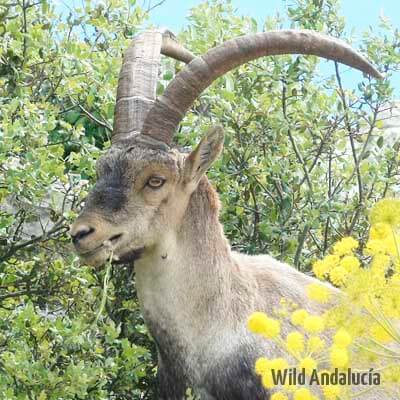 Iberian Ibex |
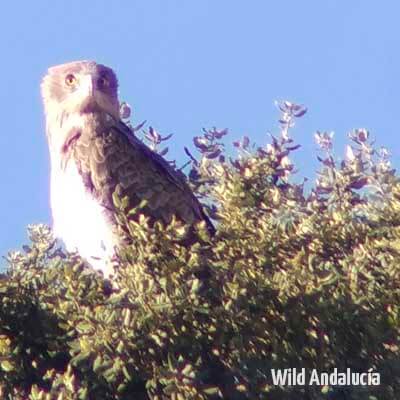 Short-toed eagle |
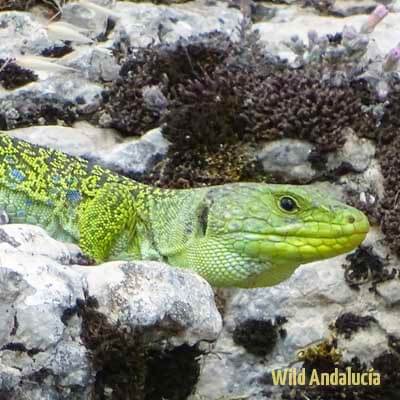 Ocellated green lizard |
|
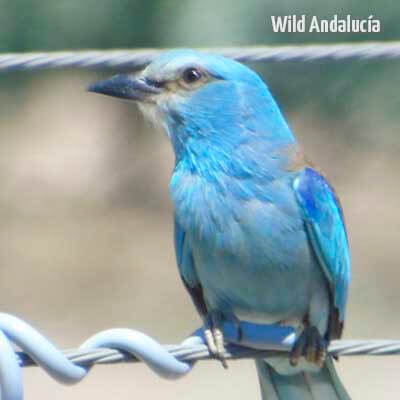 Eurasian roller |
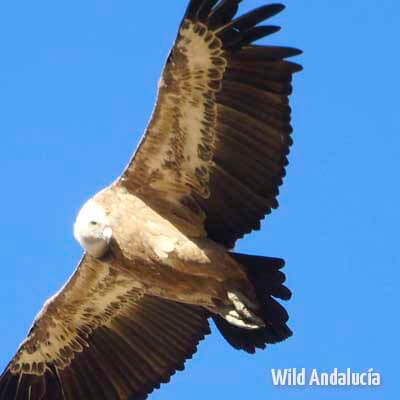 Griffon vulture |
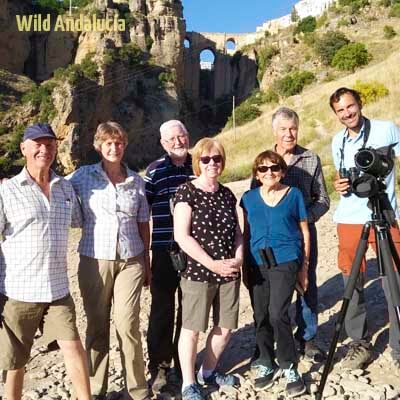 Our team Birdwatchers |
|
As always, It’s difficult to sum up the highlights of such a varied tour. Despite we were already entering June the birds performed admirably for us, while the more noteworthy sightings included Roller, Black Wheatear, Blue and Common Rock Thrushes, Booted Eagle, Western Olivaceous Warbler, White-headed Duck, Peregrine Falcon, Hoopoe, Iberian Grey Shrike, Iberian Green Woodpecker, Long-eared Owl and Subalpine Warbler. The sheer numbers on occasion of the 'commoner' species such as Crested Lark, Corn Buntings, several warblers is difficult to relate here! Although this year we’ve missed two important species (Bonelli’s Eagle and Great Bustard), the views of other unexpected birds –such a group of Long-eared Owls- was a real bonus.
As for mammals we came across a quite impressive group of male Iberian Ibex and enjoyed a family of Iberian Hares playing around. It was just Jenny who saw Egyptian Mongoose. Other Non Avian highlights included some smart butterflies, namely Moroccan Orange Tip, Southern Brown Argus, Cleopatra, Common Swallowtail, Spanish Marbled White plus Pyramid Orchid, though it was a bit late to see orchids, which happened earlier than usual this year.
The reptiles and plants also played their role during the tour, how to miss a 1.8 m Montpellier snake when it crawls next to you?
You can also watch this trip report on video: http://bit.do/solbirding
Day 1 (29/5/2019) – Málaga to Ronda area
I am glad that the arrival timings were outstanding and we all met almost at once in Málaga, where we enjoyed a quick coffee and headed for a generous welcome meal near Campillos. First “porra” soup for many, which turned out to be the official starter of the tour. After getting to our base in Ronda and having a quick rest we headed to the local river, where we saw Booted Eagle and the very elusive Western Olivaceous Warbler. We also visited the impressive Cueva del Gato to see Alpine Swifts and then headed to Ronda’s lower El Tajo to take the picture shown on the cover as the Choughs flew overhead. Time then for some tapas outdoors and soon head to bed!
Day 2 (30/5/2019) – El Torcal de Antequera & Fuentepiedra lagoon
The limestone landscape of el Torcal was our first site to visit today and it really impressed us. The Hawthorn still in blossom served as a skulking roost for Subalpine and Sardinian Warblers. We followed my favourite trail up and soon saw our darker resident Black Redstarts as Rock Sparrows called from the distance. A Thekla Lark showed up just enough to have a quick look at it. Then we came across a group of males of Iberian Ibex catching the first rays of Sun among the fast mist that coverd part of the sky and got the first Melodious Warblers. Tales of this rock labyrinth and a few fossils gave way to a beautiful dark-throated male of Black-eared Wheatear that Christine was eager to see. We took close pictures of Wren and Rock Bunting. On the way back we heard Orphean Warblers that did not obligue much and also a juvenile Cirl Bunting. Remarkable was to find a large Ocellated Lizard, probably the same one I see every year there. I won’t speak much of our big meal, but what followed after. We visited the Fuente de Piedra lagoon and its entertaining Laguneto, where we soon managed to see several White-headed Ducks despite a moderate wind. As predicted, the flamingos were breeding in big numbers, estimated at 8000 pairs. Black-necked Grebe, Sand Martin and Red-crested Pochard were also seen. Good numbers of Gull-billed Terns came by every now and then and we got close views of them. On the way back to Ronda a Hoopoe showed up to our joy. In the evening we enjoyed several local wines of Ronda and the exquisite cuisine of Entrevinos.
Day 3 (31/5/2019) – The limestone massif of central Andalusia
Today it’s been the time to check a bunch of birding locations for a few minutes. In this way we added new birds on every stop, specially when we went into our “lake district” near El Chorro Nature Reserve. A first stop gave us nice views of the local female Peregrine Falcon (hopefully the already grown up chicks were doing well). It was nice to see big numbers of Griffon Vultures passing by the same flyways every few seconds. A venturous Crag Martin flew close in between some of us, which was quite thrilling. We also got Chough, Alpine Swift and a quick blue Rock Thrush. Back near the lake we saw a family of Yellow-legged Gulls and a lonely Great Crested Grebe. We were looking for woodland passerines and soon watched the bird on our logo, the Crested Tit. It was a juvenile being fed by its parents, so it was easy to track for a few minutes. Spotted Flycatchers were seen througout our walk in the woods, but it was a pair of acrobatic Crossbills that drew our attention mostly. The calcarenite rock formations –such as taffoni- were quite interesting to see and were home to many Andalusian Wall Lizards. After lunch we headed to the higher peaks, where we enjoyed a magnificent scenry with clear blue sky. There were lots of Swallowtails hilltopping and we all had very good views of Blue Rock Thrush in front of the mighty Huma peak. A large flock of Griffon Vulture made us stop on the way back to Ronda, for excellent pictures. As we headed for dinner we saw a gorgeous male of Lesser Kestrel flying at eye level!
Day 4 (1/6/2019) – The Guadalhorce Natural Reserve
A new habitat to explore today, adding lots of species to our tour list. The Guadalhorce estuary is one of the must sites a naturalist has to visit if near Málaga city. Although the magnificence of the early spring was stronger a few weeks earlier, there were still lots of wetlands species to see. To start with, Zitting Cisticola and Monk Parakeet were coming and going all morning long. We saw a nice colony of House Martins and the local pair of Red-rumped Swallows. Common and Pallid Swifts were also seen very actively. I soon found old faces at the Reserve, which warned us about a Grey Plover. We soon saw this migratory bird, which is to some extent a great bird for us to see in breeding plummage. We made good use of the hides, from which we soon saw lots of Kentish Plovers patroling the shores, besides Flamingo, Black-winged Stilt, Kestrel, Grey Heron and Gull-billed Tern, to name a few. We particulary enjoyed the Laguna Grande lookout, getting a group of roosting Sandwich Tern in one of the islands and also a few juvenile stilts. It was also the first time we had nice and long views of Sardinian Warbler. A flock of ca. 30 Slender-billed Gulls flew overhead right after our short enconter with the –again local - big Montpellier Snake. On the way back we were surprised by a roosting Bee-eater, that posed nicely still for us.
Day 5 (2/6/2019) – The steppes of Seville
A day to scour nice birding spots within the province of Seville, more precisely near Osuna. On route we had to make a quick stop in the mountains to observe a flock of Griffon Vultures wandering around the surroundings of a dump where some carcasses had just been cleared out. Once at the farmlands our first stop was dedicated to the Little Bustard, that just some of us got the chance to identify on flight. Soon after a family of Iberian Hares delighted us looking through the scope while the juveniles were actively playing. A few Montagu’s Harriers were seen roosting and hunting around 10am, so we had a lucky start. We used some railway bridges as lookouts, and we soon noticed a few Collared Pratincoles flying low over the remaining wheat crops. This was one of the warmest days and we enjoyed a good time birding from the minibus. Both of our shrikes (Iberian Grey and Woodchat) showed up several times, but the best was just to come. On the way to the concentration areas of Eurasian Roller we chanced a couple of pairs from the road (picture below, right). It was a real excitement since none of us were expecting to have such a close view of them. As usual, scores of Crested Larks, Ravens and Corn Buntings were there too.Then we headed for lunch to a local “venta” right besides a White Stork nest. It was lovely to see how the parents were intentionally giving shade to their baby Storks. We were just missing the Great Bustard, but by the time we got to the place where I had lately been watching them this year, the crops were too high and it was a very warm day, so the chances were low. Well, we had to trade them for some feathers and –what was very surprising- a group of four Long-eared Owls roosting in a Holm Oak. We had a carefull look at the many owl pellets and found out they were basing their diet mainly on sparrow-size passerines. Happy about this encounter we continued on route and saw a Little Owl perched on a sign by the road. Hard to believe for some of the crew that we were going to see Owls at daytime on such a hot weather, that’s the magic of birding! Checking some dirt tracks we had excellent views of a Short-toed Lark sandbathing and also flying over us. We then visited a breeding colony of Spanish Sparrow, most of which had already left home but saw a few ones plus, Moorish Gecko and another pair of Roller. A Black Kite, Lesser Kestrels, a few Hoopoes and a Booted Eagle were also spotted near Osuna.
Day 6 (3/6/2019) – Sierra de Grazalema and Serranía de Ronda
We stated on our Roadbook that this day would be the jewel of the crown. The well preserved mixture of habitats found in the Ronda-Grazalema area made us tick 50 species of birds on this day, which is the record of birds per day after day 2. It is on the Sierra de Grazalema Natural Park where we guide trips more often and therefore everything was set to reveal our companions the many secrets it offers. And so we started walking along some trails along the cork oak wooden valleys. Woodlarks were singing at all times, and at some point we were able to see both of our shrikes at the same time, which was quite rewarding. A small Bee-eater colony added joy to our morning sightings, and the same for Western Bonelli’s Warbler, which was displaying quite well.
Another track gave us nice views of our first pair of Black Wheatears, quite active. We headed to the impressive Cerro Coros (picture above), from where we got eye level views of Griffon Vulture besides Black Redstart, Firecrest and Woodlark. After a traditional 2 course meal we walked around wooded and shady tracks, where we heard Golden Oriole, Short-toed Treecreeper, Wren, Cirl Bunting and Greater Spotted Woodpecker. Some of us were lucky enough to see Hawfinch on the highest branches of the poplars. Jenny saw an Egyptian Mongoose while some of us enjoyed watching a Viperine Snake hunting small fish. Then we headed to the magnificent Llanos de Líbar trail, where we got another pair of Black Wheatear and enjoyed the nest activity of several pairs of Choughs and Griffon Vultures. How noisy can they be! The track also provided Serin, Linnet, Greenfinch, Sardinian Warbler, Blackcap, Black Redstart, Blue Tit and Stonechat. Back in Ronda we met again for dinner, this time we enjoyed a delicious good-bye paella right at the Ronda gorge (picture above, right) and a Blue Rock Thrush came to check everything was in order.
Day 7 (4/6/2019) – Sierra de las Nieves to Málaga
With not so much time left for birding we decided to check the local mediterranean woods to see Nuthatch and Colin was lucky enough to get nice pictures of our Greater Spotted Woodpecker - its red-tinged breast resembles the numidus subspecies. Happy with these sightings we headed to the Natural Park Sierra de las Nieves, where we photographed Firecrest, Western Bonelli’s Warbler and Woodlark. On the way back to Málaga we saw a pair of Black Wheatear and a stunning male of Common Rock Thrush just by the road, which made us all very happy, what a great last species for the tour this is!
We can’t but thank our friendly group for such an enjoyable birding tour, which also served as an important benchmark on our central Andalusia expeditions.
We hope you've enjoyed reading our amazing Costa del Sol Birding Tour report.
Sincerely,
Álvaro Peral, manager in Wild Andalucía Birding Tours
A total of 119 bird species were recorded, with 6 of them heard only and 1 of which was heard only by the tour leader.
Note: this bird list is designed to minimize the time spent to find a species. Therefore common names are alphabetically ordered and simplified. For the same reason not all of them match the IOC world list.
Alpine Swift
Bee-eater
Black Kite
Black Redstart
Black Wheatear
Blackbird
Blackcap
Black-eared Wheatear
Black-headed Gull
Black-necked Grebe
Black-winged Stilt
Blue Rock-thrush
Blue Tit
Bonelli's Warbler, western
Booted Eagle
Buzzard
Calandra Lark
Cattle Egret
Cetti's Warbler
Chaffinch
Chough
Cirl Bunting
Collared Dove
Collared Pratincole
Common Swift
Coot
Corn Bunting
Crag Martin
Crested Lark
Crested Tit
Crossbill
Cuckoo
Dartford Warbler
Feral Dove
Firecrest
Flamingo
Golden Oriole
Goldfinch
Great Crested Grebe
Great Spotted Woodpecker
Great Tit
Green Woodpecker, iberian
Greenfinch
Grey Heron
Grey Plover
Grey Wagtail
Griffon Vulture
Gull-billed Tern
Hawfinch
Hoopoe
House Martin
House Sparrow
Jackdaw
Jay
Kentish Plover
Kestrel
Lesser Black-backed Gull
Lesser Kestrel
Linnet
Little Egret
Little Grebe
Little Owl
Little Ringed Plover
Long-eared Owl
Mallard
Melodious Warbler
Mistle Thrush
Monk Parakeet
Montagu's Harrier
Moorhen
Nightingale
Nuthatch
Olivaceous Warbler, western
Orphean Warbler, western
Pallid Swift
Peregrine Falcon
Pochard
Quail
Raven
Red-crested Pochard
Red-legged Partridge
Red-rumped Swallow
Redshank
Reed Warbler
Robin
Rock Bunting
Rock Dove
Rock Sparrow
Rock-thrush
Roller
Sand Martin
Sandwich Tern
Sardinian Warbler
Serin
Shelduck
Short-toed Lark
Short-toed Treecreeper
Shoveler
Slender-billed Gull
Southern Grey Shrike
Spanish Imperial Eagle
Spanish Sparrow
Spotless Starling
Spotted Flycatcher
Stonechat
Storm Petrel
Subalpine Warbler
Swallow
Thekla Lark
Turtle Dove
White Stork
White/Pied Wagtail
White-headed Duck
Wood Lark
Wood Pigeon
Woodchat Shrike
Wren
Yellow-legged Gull
Zitting Cisticola (Fan-tailed Warbler)
REPTILES:
Andalusian Wall Lizard
Large Psammodramus
Ocellated Green Lizard
Moorish Gecko
Montpellier Snake
Viperine Water Snake
Spanish Pond Turtle
Yellow-bellied Slider